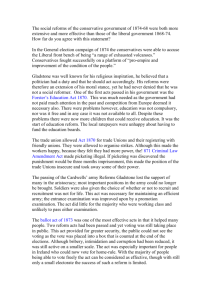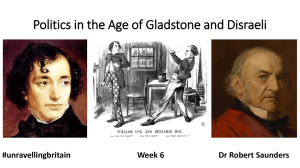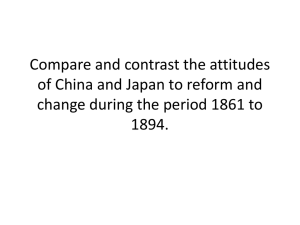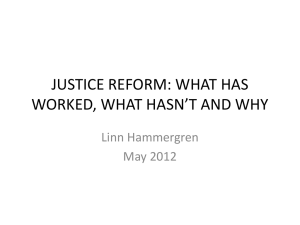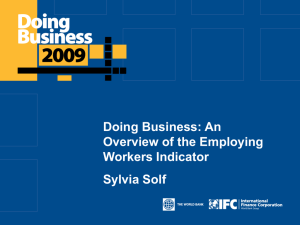Disraeli`s social Reformsanswers
advertisement
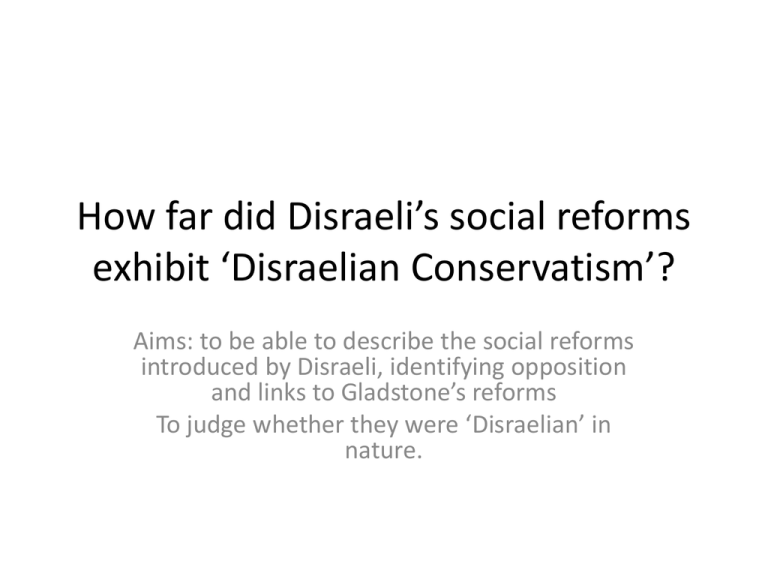
How far did Disraeli’s social reforms exhibit ‘Disraelian Conservatism’? Aims: to be able to describe the social reforms introduced by Disraeli, identifying opposition and links to Gladstone’s reforms To judge whether they were ‘Disraelian’ in nature. Which social reform belongs to which leader? Forster’s Education Act Conspiracy and Protection of Property Act Artisans’ Dwellings Act Civil Service Act Secret Ballot Act Public Health Act Disraeli’s Social/ Domestic Reforms Name/ Date of Social Reform What the reform was trying to achieve Factory Act 1874 • • • • • Licensing Act 1874 • • Public Worship Act 1874 Sale of Food and Drugs 1875 • • Source of / reasons for opposition/ way in which Disraeli was responding to Gladstone’s Domestic reforms Max hours for women and children to be 56.5 per week Children under 10 not to be employed No full time work until a child was 14 • Opening hours extended by 30 mins Clauses from 1872 Act to stop watering of beer removed Fewer police rights to enter pubs .An Act designed to suppress the growth of ritualism in the C of E. • • • Est. rules for preparation of food for sale Set up inspectors to detect adulterated food e.g. chalk in flour Reward brewers and publicans for their support in the election Sop to brewers/ publicans upset by 1872 legislation The imprisonment of four priests for contumacy between 1877 and 1882 discredited the Act. No compulsion for local authorities to appoint inspectors, so not effective Name/ Date of Social Reform What the reform was trying to achieve Source of / reasons for opposition/ way in which Disraeli was responding to Gladstone’s Domestic reforms Agricultural Holdings Act 1875 Revamped the law on tenant rights so tenants received consistent levels of compensation for the value of their improvements to the holding and any crops in the ground. It also gave tenants the right to remove fixtures they had provided, increased the period of a Notice to Quit from six months to twelve, and brought in an agricultural dispute resolution procedure Some Landlords reacted to the 1875 Act by refusing to let land on a tenancy, instead contracting out the labour to contract farmers. Artisans’ Dwelling Act 1875 • Local authorities could buy slums and rebuild with more sanitary houses • • • Influenced by Cholera outbreak 1866-7 No compulsion so generally ignored Joseph Chamberlain (Birmingham used to great effect) Conspiracy and Protection of Property Act 1875 • • Peaceful picketing became legal Unions could act legally as a group and so could strike • Liberal Act of 1871 had been very unpopular Employers and Workmen Act 1875 • Replaced Master and Servant Act with more equal terms Both employers and workmen were on equal footing in cases of breach of contract It became a civil offence to break contracts • • Friendly Societies Act 1875 Societies provided insurance for w/c Royal Commission set up as there were fears they were financially unsound Societies to register voluntarily Table of model premiums drawn up but permissive Infants could still be insured but for limited amounts Name/ Date of Social Reform What the reform was trying to achieve Public Health Act 1875 • Local authorities to provide adequate drainage, water supply and sewage disposal • Offensive items in streets to be removed • Markets, street lighting and burial regulated • Infections diseases notified Rivers Pollution Act 1875 • Noxious substances not to be dumped in rivers • Prosecution needed local government permission so rarely happened Education Act 1876 • Local School Attendance Committees made attendance compulsory • Children under 10 not to be employed • Children aged 10-14 could work part time if they had a certificate of attendance and academic attainment • Unnecessary school boards could be dissolved Source of / reasons for opposition/ way in which Disraeli was responding to Gladstone’s Domestic reforms • Based on Royal Commission • Aim was to help Anglican schools in competition with rate-funded board schools Enclosures Act 1876 • Common land to be preserved for public use. Led to the ‘green belt’ • Epping Forest safeguarded for Londoners’ recreation in 1878 as a result Merchant Shipping Act 1876 • Stop-gap measure • Plimsoll line to be painted on ships to • Pressure from Samuel Plimsoll and Tory show the max loading point. In reality MPs for ports to stop overloading ships painted on ships wherever owner wanted so did little to ensure safety of sailors Name/ Date of Social Reform What the reform was trying to achieve Trade Union Amendment Act 1876 • Factory and Workshops Act 1878 The Trade Union Amendment Act 1876 extended protection of funds to all trade unions, not just to those which would otherwise have been 'in restraint of trade'. • Local authorities to inspect workshops employing fewer than 50 people Source of / reasons for opposition/ way in which Disraeli was responding to Gladstone’s Domestic reforms How far did Disraeli’s social reforms exhibit ‘Disraelian Conservatism’? Not Disraelian Conservatism In which case what would you call it? Disraelian Conservatism
